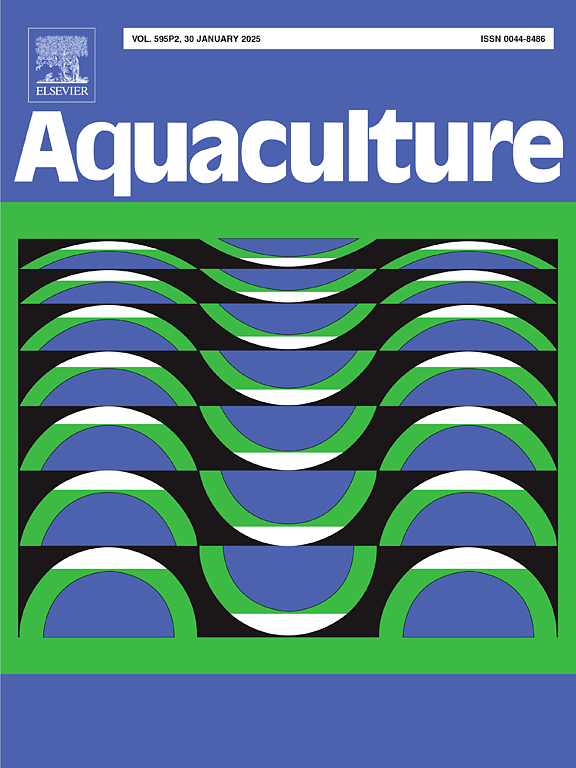口服副溶血性弧菌噬菌体Фvp140在凡纳滨对虾体内的药动学研究
IF 3.9
1区 农林科学
Q1 FISHERIES
引用次数: 0
摘要
噬菌体(噬菌体)是细菌的天然捕食者,在预防和治疗虾类细菌感染方面已被证明是抗生素的潜在替代品。为了解噬菌体能否有效到达感染部位,研究了副溶血性弧菌噬菌体Фvp140在凡纳滨对虾(Litopenaeus vannamei)体内灌胃和给药后的药代动力学。无论是灌胃还是给药,噬菌体Фvp140都能迅速分布到对虾的各个组织中。噬菌体滴度在肠道中最高,其次是肝胰腺,其噬菌体滴度约为肠道的10%,只有少量噬菌体能进入循环系统。一个简单的指数衰减模型可以有效地描述每个组织中噬菌体的消除,并且剂量越高,消除速度越快。肝胰腺中噬菌体的清除速度最快,而肠道中噬菌体的清除速度与(灌胃)相似或快于(喂药)血淋巴。三次灌胃后,对虾组织中噬菌体滴度呈剂量依赖关系。本研究发现,口服噬菌体后,大量噬菌体可直接进入肝胰腺。虽然噬菌体很快消失,但通过药物饲料持续口服对虾的噬菌体使肝胰腺中噬菌体滴度维持在高水平。本研究为噬菌体在对虾养殖中的应用提供了药代动力学依据,为进一步优化噬菌体治疗奠定了基础。本文章由计算机程序翻译,如有差异,请以英文原文为准。
Pharmacokinetic study of Vibrio parahaemolyticus phage Фvp140 in Litopenaeus vannamei following oral administration
Bacteriophages (phages) are natural predators of bacteria, and have been shown to be potential alternatives to antibiotics in the prevention and treatment of bacterial infections of shrimp. In order to understand whether phages can effectively reach the site of infection, the pharmacokinetics of Vibrio parahaemolyticus phage Фvp140 in Litopenaeus vannamei was investigated following oral administration by gavage and via medicated feed. Whether administered by gavage or via medicated feed, phage Фvp140 could be rapidly distributed to various tissues of shrimp. The phage titer was the highest in the intestine, followed by the hepatopancreas, whose phage titer was about 10 % of that in the intestine, and only a small amount of phages could enter the circulatory system. A simple exponential decay model could effectively describe the elimination of phages in each tissue, and the higher the dose, the faster the elimination rate. The elimination rate of the phage in the hepatopancreas was the fastest, while the elimination rate of the phage in the intestine was similar to (by oral gavage) or faster than (via medicated feed) that in hemolymph. After oral gavage at three doses, the phage titers in shrimp tissues showed a dose-dependent relationship. This study found that after oral administration of phages, a large number of phages could directly into the hepatopancreas. Although the phage eliminated quickly,the continuous oral administration of phages in shrimp via medicated feed enabled the maintenance of a high level of phage titers in the hepatopancreas. This study provided pharmacokinetic evidence for the application of phage in shrimp farming and laid the foundation for further optimization of bacteriophage therapy.
求助全文
通过发布文献求助,成功后即可免费获取论文全文。
去求助
来源期刊

Aquaculture
农林科学-海洋与淡水生物学
CiteScore
8.60
自引率
17.80%
发文量
1246
审稿时长
56 days
期刊介绍:
Aquaculture is an international journal for the exploration, improvement and management of all freshwater and marine food resources. It publishes novel and innovative research of world-wide interest on farming of aquatic organisms, which includes finfish, mollusks, crustaceans and aquatic plants for human consumption. Research on ornamentals is not a focus of the Journal. Aquaculture only publishes papers with a clear relevance to improving aquaculture practices or a potential application.
 求助内容:
求助内容: 应助结果提醒方式:
应助结果提醒方式:


